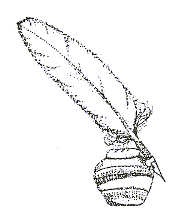
Then Nöãch became a son of five hundred year (500 years) ~ and Nöãch caused to bring forth Shëm, Chäm, and Yäpheth # (Genesis 5.32, dmd translation)
Traditionally, Shem is considered the eldest son of Noah because of the assumption that Noah's sons are listed in birth order in Genesis 5.32. In addition, a phrase in Genesis 10.21 is usually translated as "Shem the elder brother of Japheth." But is the traditional interpretation correct? Is Shem the eldest son? Are the sons listed in birth order? The Question A closer look at the words in Genesis 9.22-24 raises the question of whether Genesis 5.32 lists Shem, Ham, and Japheth in their birth order.
"Now Chäm, the father of Kenaøan, saw the nakedness of his father ~ and he made [it] known to his two brothers outside". . . . . Then Nöãch woke from his wine ~ and he knew what his son the younger (or the youngest) "benø haqqätän" had done to him # (Gen 9.22, 24, dmd translation)
If Ham was Noah's youngest son, then "Shem, Ham, and Japheth" is not a birth order listing. Also, the New American Standard Bible (1977 ed.)(1) provides an alternate translation of Genesis 10.21: "or, Shem the brother of Japheth the elder."
"and to Shëm were brought forth also ~ the father of all of the sons of Eber, @áchî Japheth haggädhôl # (the brother of Japheth the elder or the elder brother of Japheth) (Genesis 10:21, dmd translation)
According to Hebrew grammars,(2),(3) both translations have equal validity in Hebrew grammar and syntax. So, which is the correct translation? A Logic Puzzle In His wisdom, Rûãch @Élôhîm provided the answer through what amounted to a logic puzzle using three Scriptures as the clues.
1) "Then Nöãch lived a son of 500 years ~ and Nöãch caused to bring forth Shëm, Chäm, and Yäpheth #" (Genesis 5.32) 2) "Now Nöãch [was] a son of 600 years ~ and the Flood became waters over the land #" (Genesis 7.6) 3) "Shëm [was] a son of a hundred years and he caused to bring forth @Arpakhshädh ~ two years after the Flood # (Genesis 11.10b)
Solving the Puzzle
1) If Noah was 500 years old when he became a father and 600 years old at the Flood, then his eldest son would have been 100 years old at the Flood. 2) If Shem was 100 years old when Arpachshad was born, two years after the Flood, then he was 98 years old at the Flood. Therefore, Shem is not Noah's eldest son, and the correct translation is "Shem the brother of Japheth the elder."
Birth order of Noah's sons: Japheth, Shem, and Ham? Scripture describes Ham as "the younger or the youngest" and Japheth as "the elder." There's nothing indicating Shem's birth order position. It seems likely that Shem was the one in the middle. Also, if Shem did indeed write the original of Genesis 6.9b-11.10a(4), it seems likely that Shem, being the one in the middle writing about his brothers, would call Japheth "the elder" and Ham "the younger" because that's their birth order in relation to him. Still, there is this question: If the birth order is Japheth, Shem, and Ham, then why is Shem listed first in Genesis 5.32? Possibly because the Line of the Promise (which was the Abrahamic/Davidic line) ran through him. Even if Shem originally provided a correct birth order listing, later scribes might have put Shem first and moved Japheth to the last position to reflect the supremacy of the Abrahamic/Davidic line. Traditional Interpretations The idea that Shem was the eldest son of Noah and born when Noah was 500 years old is firmly established in both the Jewish and Christian traditions. This understanding is found in nearly all writings for centuries, even millennia, but it's a misunderstanding based on the assumption that Noah's sons are listed in birth order. At some point in time, it was forgotten that Genesis 5.32 does not list Noah's sons in birth order, and that Shem was a second son. The reading became literal. This reading has persisted down through the generations and led to inaccuracy in Jewish and Christian writings for millennia. Fortunately, Rûãch @Élôhîm provided clues in His written word for those who questioned the birth order to find the clues and to deduce the truth. The traditional understanding simply does not stand up to a detailed examination of the relevant Scriptures. Conclusion Based on the information provided in Scripture, the correct birth order of Noah's sons is Japheth, Shem, and Ham.
FOOTNOTES (1) Lockman Foundation. New American Standard Bible, Reference Edition. La Habra, CA: Foundation Press Publications.1973, 1334p, 396p, 115p Return (2) Practico, Gary D. and Van Pelt, Miles V. Basics of Biblical Hebrew Grammar. Grand Rapids: Zondervan. 2001, 476p Return (3) Waltke, Bruce K. and O'Connor, M. An Introduction to Biblical Hebrew Syntax. Winona Lake, IN: Eisenbrauns. 1990, 765p. Return (4) As discussed in dmd essay, Patterns in Genesis Return Return to blog post Return to ICB Menu
Site Creator: Dori This page last modified: February 4, 2021 Send correspondance to: dori@badgerholt.com Legal Stuff: Copyright 2021 by D.M. Doede. All rights reserved. Permission to distribute this material via e-mail, or individual copies for personal use, is granted on the condition that it will be used for non-commercial purposes, will not be sold, and no changes made to the format or content. When quoting, please keep the context and provide the source URL: https://www.badgerholt.com. Scriptures are cited from New American Standard Bible (NASB), English Standard Version (ESV) Young's Literal Translation (YLT), Geneva Bible, 1599 ed., Jay Green's KJ3' Literal Translation, Gary Zella's Analytical Literal Translation of the New Testament, or my own translation (dmd).